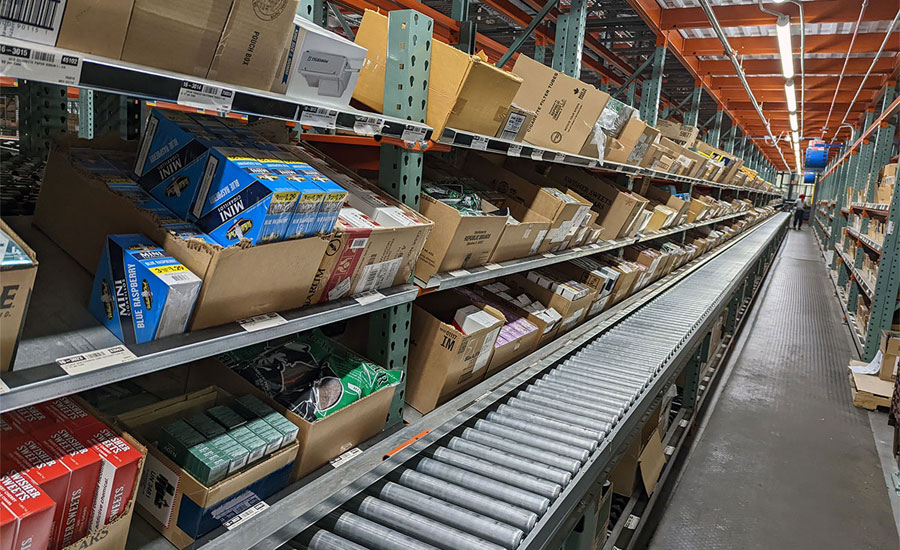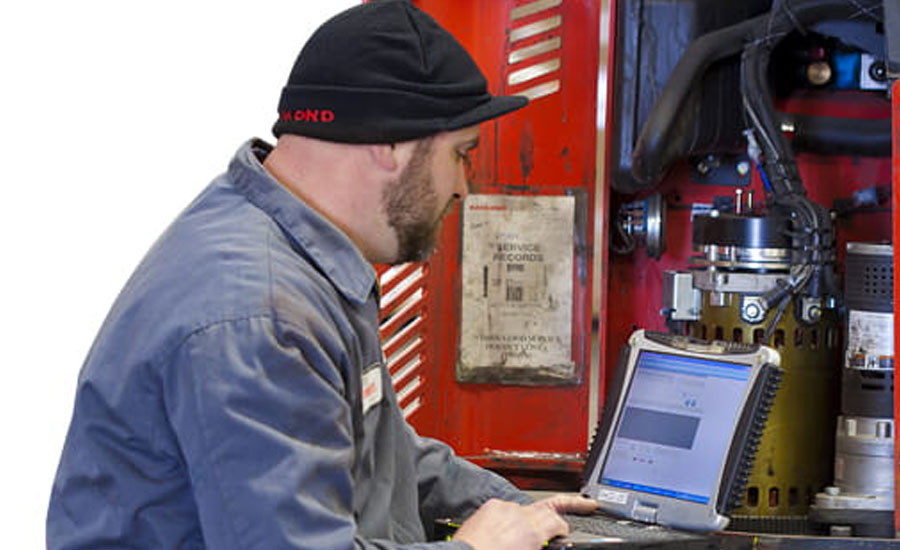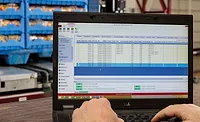Warehouse
Easily integrated software packages boost warehouse efficiencies
Warehouse software solutions address beverage operations’ many challenges

Image courtesy of Getty Images
In the 1952 “I Love Lucy” episode “Job Switching,” popularly known as the Chocolate Factory episode, Lucy and Ethel try to prove to their husbands that a job outside of home is easier than housework, so the couples “switch.” As the guys stay at home and end up burning clothes and dinner, Lucy and Ethel, while working at a chocolate manufacturing facility, end up stuffing their faces and clothes with chocolates in order to keep pace with the conveyor belt.
In today’s real world beverage operations, where warehouses are facing issues of keeping pace with distribution, experts note that integrating warehouse software solutions can improve efficiencies.
“With customers needing products faster than ever, larger beverage wholesalers need to find ways to get more products out the door on time,” says John Rosenberger, director of iWAREHOUSE GATEWAY and global telematics at The Raymond Corp., Greene, N.Y. “Because of this, many wholesalers are looking to make changes but ones that have a lesser impact on infrastructure and cost.”
As warehouse management or location systems can be integrated onto equipment or in the warehouse with minimal changes, Rosenberger notes that such software solutions can offer insights that can help save money and boost efficiencies in the future.

Image courtesy of Lucas Systems
Ken Ramoutar, chief marketing officer at Lucas Systems, Wexford, Pa., notes that with more beverage distributors turning to consolidation for efficiency purposes, flexible software solutions become crucial.
“There has been a strong trend of creating ‘mega distributors’ especially in the beer, wine and spirits sectors of the beverage industry,” he explains. “Much of the consolidation has been through the acquisition of many small distributors aggregating them into a larger entity for the purposes of scale and efficiency. With that business strategy comes the IT challenge of integrating or switching acquired companies on to a unified set of systems to manage ordering, inventory, warehousing operations, logistics and billing, for example.
“What becomes critical in choosing warehousing software is the capability to easily integrate and work with multiple back-end systems at the same time,” he continues. “In many cases, it takes years for an IT consolidation strategy to fully play out. Software that is easy and agile enough to receive and pass data back and forth to multiple WMS, ERP, TMS or WES systems, without a lot of IT resources that can be implemented within a relatively short window, becomes a critical factor in choosing warehouse software.”
Kyle Nevenhoven, principal consultant at Dematic, Atlanta, notes that with consolidation, comes the need for more complex WES and WCS solutions.
“Consolidation is impacting the scale of warehouses, which require more complex WES and WCS software packages, as well as automation in some cases as the traditional lightweight WMS models do not scale to these large operations,” he explains. “Consolidation also increases the need to have visibility across a more complex ecosystem, linking intelligence from multiple facilities to have visibility to inventory, capacity and productivity.”
An SKU evolution
Along with companies across the industry continuing to expand in locations and the number of suppliers, comes the challenge of handling higher SKU counts, experts note.
Dave Williams, vice president of technology solutions at York, Pa.-based Westfalia, notes that with greater SKU proliferation, the rules and complexities of dealing with those individual SKUs present challenges from an order fulfillment standpoint.
“When dealing with a small number of SKUs (a couple hundred) it’s easier to manage inventory and fulfillment,” Williams says. “Particularly in the beverage industry, as warehouses start seeing thousands of SKUs not only due to variety but how each item is packaged, beverage manufacturers and distributors need detailed visibility of their inventory.
“With higher proliferation comes a tremendous amount of information and rules, each helping to distinguish products from one another. Even time-sensitive packaging or promotions have to be considered and tracked for timely fulfillment,” he continues. “It’s not only the complexity of handling a higher volume of SKUs, it is how a company wants to utilize those SKUs to fulfill orders and drive sales.”
Paul Laman, vice president of beverage at DMW&H, Fairfield, N.J., echoes similar sentiments, noting that with greater volume and more SKUs in a facility, utilizing the best of breed software will allow a distributor to better handle these increases in demand and complexity.
“With an increase in SKUs, the warehouse storage density decreases, which emphasizes the need for optimal use of the storage systems,” he adds. “The software needs to manage the storage rules well to preserve the best space utilization possible.”
Lucas’ Ramoutar suggests that software solutions should have the flexibility to adapt to an ongoing evolution of SKU changes and velocities.
“The largest impact is on the warehouse floor, where pickers and selectors have to fulfill a larger variety of SKUs creating more physical work per day, and a greater chance for errors,” he says. “Software that helps beverage wholesalers efficiently manage the actual work done on the floor and keeps labor costs down, becomes a critical part of the fulfillment operation.”

Image courtesy of The Raymond Corp.
The ever-changing beverage market
With the beverage market constantly evolving, experts highlight how market trends can affect operations.
One trend, largely affecting beverage wholesaler operations, is the move to direct-to-consumer, Lucas’ Ramoutar says.
“While there are restrictions in the alcoholic beverage segment today, other non-alcoholic segments will see pressure to fulfill directly to consumers,” he explains. “For example, the large retail online marketplaces such as Amazon and Walmart require much of their product sales to be fulfilled directly from the manufacturer or distributor.
“eCommerce fulfillment has a massive impact on a distribution center operation as the fulfillment model shifts to a stream of high volume, smaller orders, with varying priorities on shipment,” he continues. “Software that is able to help manage the operations in a real time, order streaming way, with the smarts to make data driven decisions will become the norm to compete.”
Westfalia’s Williams notes that with new product trends constantly emerging on the scene, such trends force warehouses and distribution centers (DC) into performing a balancing act.
“It seems like there are constantly new emerging trends when it comes to the beverage industry,” he says. “The energy drink craze, craft brews and seltzer alcohol trends are only three timely examples, but there will always be mainstays in any industry. For example, Bud Light and Coors will always be produced, but when White Claw became trendy, many warehouses and distribution centers had to adjust to the influx of demand and figure out viable distribution processes, and this balancing act between mainstay and trendy products is always a software challenge for DCs.
“Because brick and mortar stores typically no longer have the on-site storage capacity compared to the past, more companies are demanding mixed pallets of product,” Williams continues. “The complexity of fulfilling these orders along with a lack of manual labor makes intelligent warehousing software a must-have for smooth order fulfillment.”
Further, with the growing trend of urbanization, comes many new challenges facing DCs and warehouses, experts note.
“Some of these include space constraints, high land costs and last-mile delivery — more specifically, delivery within the last 50 feet,” Raymond Corp.’s Rosenberger says.
Tom Swovick, market development director at Dematic, notes that urbanization only creates more complex delivery routes with more diversity of products being delivered.
“Sustainability initiatives are driving change in creatively solving for last mile delivery. Major retailers are pushing wholesales to a truck to shelf replenishment and delivery model, creating more frequent and smaller deliveries,” he says. “B2B eCommerce (retailers ordering via EDI transactions or other electronic means) allow for advanced visibility to orders, in turn opening the door for extending the hours available for order processing in the warehouse.”
Moreover, with consumers able to find what they want at one location, today’s consumers hold high expectations on the delivery of products, Rosenberger notes.
“Previously, buyers would find themselves at numerous stores looking for different products, but now with many distribution companies across the country, consumers can find what they want at one location like a grocery store or gas station, '' he explains. “Because of this, it is important to maximize the distribution process.”
Advanced technologies now, and for the future
As the beverage industry works to become more dynamic and responsive to consumer demands, experts note that, the need for smarter, real-time decision-making software is becoming increasingly important.
DMW&H’s Laman notes that, although WMS now is standard in all warehouses and DCs, more advanced technology, such as WCS, is becoming crucial to order fulfillment.
“The WCS is critical in delivering the best fulfillment methodologies as the volumes and business profiles migrate and grow,”Laman says. “Flexibility is also needed throughout the production shift for the different order profiles.
“Regarding the WCS, the latest benefit is advanced wave picking algorithms to simultaneously handle the full range of customer delivery stop profiles from small bar deliveries as well as big chain stores and everywhere in between,” he continues.
Dematic’s Nevenhoven notes that AI based advanced slotting algorithms increase productivity by grouping and placement of SKUs.
“WES is taking over WMS functionality for more holistic processing and tighter coupling of manual and automated processes,” he says.
Lucas’ Ramoutar notes that where travel can often account for up to 40% of a selector’s time, smart software can reduce that travel time by as much as 30% through intelligent batching of work and travel path optimization.
“The latest advancement in warehouse software solutions revolves around making the software smarter through the use of AI and machine learning technologies,” Ramoutar says. “Lucas Systems, for example, has been using AI and machine learning to help on-floor workers reduce travel within the warehouse.”
Westfalia’s Williams notes that having more robust, flexible, and powerful systems that are easy to operate is a constant improvement goal in warehouse automation and software solutions.
“For example, Westfalia’s Savanna.NET Firefly is a fault recovery and visualization tool that provides colorized, 3D models showing real-time flow of pallets and any potential disruptions within the warehouse so that they can be addressed in a timely manner,” he says.
Raymond Corp.’s Rosenberger points to the company’s continual work to provide its customers with software solutions that works toward connectivity and can help gain visibility of the entire warehouse.
“The iWAREHOUSE Fleet and Warehouse Optimization System is a telematics system that allows operations to gather valuable information directly from their fleet, assets and workforce to enhance efficiency and reliability,” he says. “This comprehensive telematics suite of solutions tracks and reports on vehicle and operator utilization and data to help drive productivity across your operations.”
Integrating software solutions
To take advantage of the latest software packages, experts note that warehouses and distributors should take the time to understand technological advances, as well as the best practices companies similar to themselves are using.
“It is key to consider the ability of software to adapt, with ease, to uncertainty and an ever-changing set of market requirements,” Dematic’s Swovick says. “It is key to look for a system that leverages standard building blocks for proven functionality yet is highly configurable to allow for application to the unique processes and business rules of the organization.”
Raymond Corp.’s Rosenberger suggests that when looking to update operations, warehouses should consider optimizing first.
“One of the most beneficial things you can do for your warehouse is to optimize it before you automate it,” he says. “The data used to optimize can provide valuable insights into what works in your warehouse and what doesn’t while creating more space for products and improving workforce productivity and overall efficiency.”
Westfalia’s Williams adds that decision makers should take a deep look at the partnership with potential solution providers.
“Prioritize companies that have the resources to individually focus on your software needs,” he says. “Letting a software system go legacy is a huge drain of resources, the right software solution should grow with a business and not cost millions to keep it updated.”
Looking for a reprint of this article?
From high-res PDFs to custom plaques, order your copy today!





